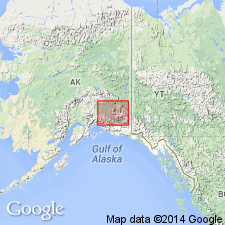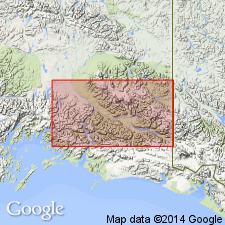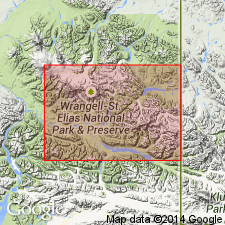
- Usage in publication:
-
- Kennicott series*
- Modifications:
-
- Named
- Dominant lithology:
-
- Arkose
- Shale
- Limestone
- AAPG geologic province:
-
- Alaska Southern region
Summary:
Occurs in beds between Fohlin Creek and summit of Kennicott Pass [later called Fourth of July Pass] and east of Kennicott Glacier. Outliers occur northward at edge of Skolai Range. Shown on geologic sketch map of Wrangell Mountains and adjacent area. Is series of light-gray coarse-grained arkoses, shales, slates, limestones, and conglomerates. Unconformably (?) overlies McCarthy Creek shales (new). Species of AUCELLA found at Fohlin Creek were identified by T.W. Stanton as of Jurassic age. Map legend gives age of series as Jurassic and Cretaceous.
Source: GNU records (USGS DDS-6; Menlo GNULEX).

- Usage in publication:
-
- Kennicott formation*
- Modifications:
-
- Age modified
- AAPG geologic province:
-
- Alaska Southern region
Summary:
Rocks of type locality of Kennicott formation (Rohn, 1900) in Fourth of July Pass [formerly Kennicott Pass] now considered to be of Early Cretaceous age. Section described at Fourth of July Creek includes (ascending): conglomerate (few ft), massive brown sandstone (100 to 200 ft), crumbly gray shale (50? ft), and black shale or slate intruded by dikes (possibly 3000 ft). Mapped undivided with shale, sandstone, and conglomerate on geologic map of Chitina Valley and adjacent area.
Source: GNU records (USGS DDS-6; Menlo GNULEX).

- Usage in publication:
-
- Kennicott Formation*
- Modifications:
-
- Revised
- Overview
- Biostratigraphic dating
- AAPG geologic province:
-
- Alaska Southern region
Summary:
Historical overview of use of name "Kennicott" included in report. Kennicott Formation redefined to include conglomerate, sandstone, siltstone, and shale that constitute lowermost sequence of rocks unconformably overlying Triassic rocks in McCarthy B-6 and C-6 quads. Type locality designated as hillsides east of Fohlin Creek and north of Bear Creek mainly in southwestern part of McCarthy C-6 quad. Unit is widely distributed in McCarthy quad. Shown on sketch map of parts of McCarthy quad. Thickness ranges from few 10's of ft to almost 500 ft. Unconformably overlies Nikolai Greenstone, Chitistone Limestone, Nizina Limestone, McCarthy Formation, and Nizina Mountain Formation. Conformably or disconformably underlies Schulze, Moonshine Creek and Chititu Formations; locally unconformably underlies Quaternary sedimentary deposits. Cut by dikes and small plutons of felsic Tertiary intrusive rocks. At its type unit is locally overlain by massive conglomerate 80 ft thick. Can be subdivided into 2 well-defined faunal zones of early Albian age -lower MOFFITES ROBUSTUS and upper BREWERICERAS HULENENSE zones (Jones, 1967).
Source: GNU records (USGS DDS-6; Menlo GNULEX).
For more information, please contact Nancy Stamm, Geologic Names Committee Secretary.
Asterisk (*) indicates published by U.S. Geological Survey authors.
"No current usage" (†) implies that a name has been abandoned or has fallen into disuse. Former usage and, if known, replacement name given in parentheses ( ).
Slash (/) indicates name conflicts with nomenclatural guidelines (CSN, 1933; ACSN, 1961, 1970; NACSN, 1983, 2005, 2021). May be explained within brackets ([ ]).

